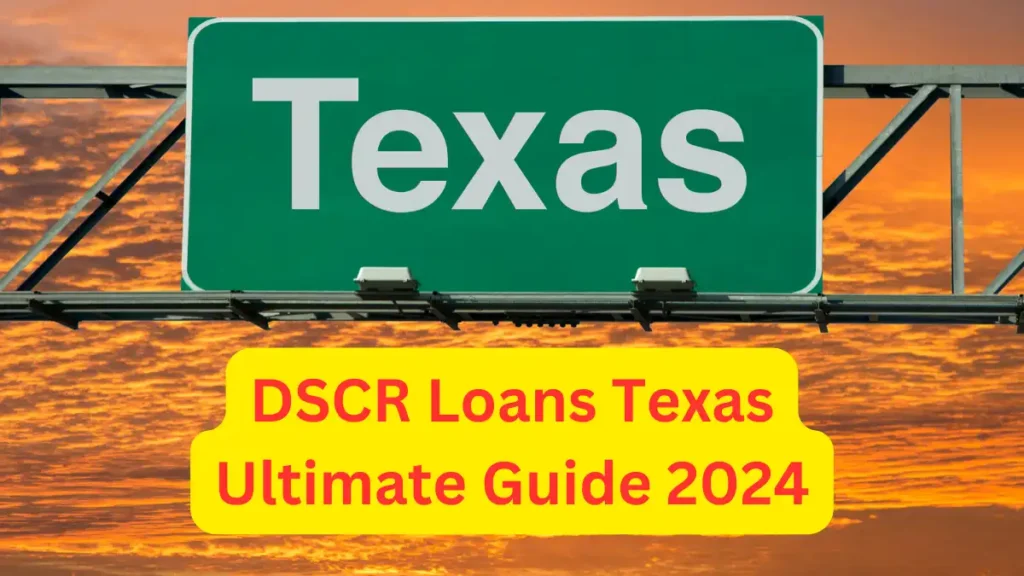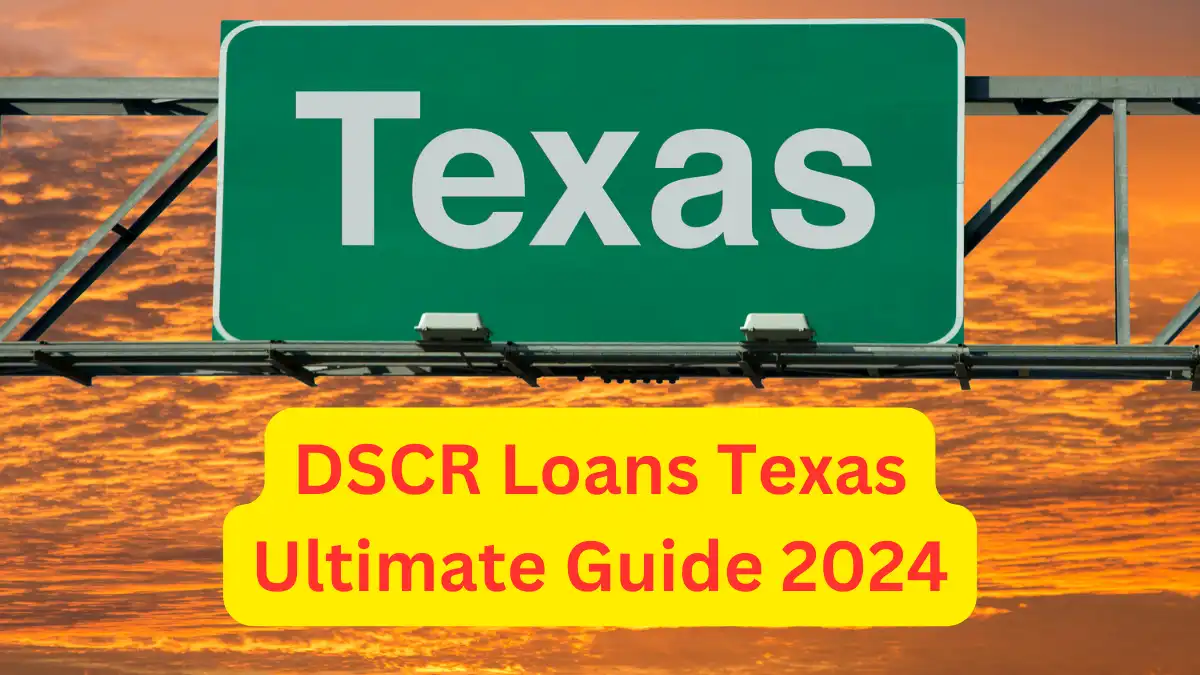DSCR Loans Texas: Did you hear that the interest rates for DSCR loans are 1% lower now compared to before? This drop in rates is making more investors and borrowers interested, especially in Texas where the real estate market is strong. DSCR loans check if a property can pay its debts. They’re becoming popular for commercial real estate projects in Texas because the rates are good, and the economy is growing well. Texas is a great place for people looking for loans that fit their investment plans.

DSCR Loan Texas
DSCR loans are basically mortgages for rental properties. DSCR stands for debt service coverage ratio, which is a simple way to see if a rental property can pay its mortgage. If the DSCR is 1.0, it means the property just breaks even. If it’s above 1.0, the property makes more than enough to pay the mortgage. But if it’s below 1.0, the property doesn’t earn enough to cover the mortgage, so the owner has to put in extra money each month or raise the rent.
In Texas, rental properties are still a good investment even when interest rates are going up and staying high. When interest rates are high, the DSCR goes down. So it’s important to pick rental properties that bring in good rent compared to their price. Some people use the 1% rule, which says the rent should be at least 1% of what you paid for the property. If the rent is too low compared to the property’s price, the DSCR will be too low for the loan you want, and you’ll need to put in more money upfront. Putting in more money upfront might work, but it’s not the best if you’re trying to make the most of your investment.
DSCR Loan Texas Requirements
| Requirement | Details |
|---|---|
| Minimum DSCR | 1.0 or higher |
| Property Type | Primarily for investment properties (single-family, multi-family, condos) |
| Minimum Credit Score | Varies by lender, typically 640+ |
| Down Payment | Varies by lender, typically 20-25% |
| Debt-to-Income Ratio (DTI) | May not be considered as heavily as with traditional mortgages |
| Income Documentation | Not typically required, focus on rental income projections |
| Property Valuation | Accurate appraisal required to determine LTV |
| Rental Income Documentation | May be requested to support projections |
| Reserves | Some lenders may require cash reserves to cover unexpected expenses |
| Experience | Some lenders may prefer borrowers with experience in investment property management |
Additional Points:
- LTV (Loan-to-Value) ratios can be higher than traditional mortgages, up to 80%.
- Interest-only options may be available for a set period.
- Closing times can be faster than traditional mortgages.
- Higher interest rates are common compared to traditional mortgages.
- Carefully consider the risks associated with relying solely on rental income.
DSCR Loan Interest Rates In Texas
DSCR loan interest rates in Texas are a bit more dynamic than their traditional mortgage counterparts. They play a delicate balancing act between lender risk assessment and the borrower’s investment potential. Here’s what you need to know:
Current Landscape:
- Average Range: As of January 2024, DSCR loan interest rates in Texas typically fall within the 7.25% – 8.25% range for 30-year fixed-rate loans.
- Factors Influencing Rates: DSCR, credit score, Loan-to-Value (LTV) ratio, property type, borrower experience, and prepayment penalties all play a role in determining your specific rate.
- Benchmark: The current 5-year US Treasury yield (around 4.03% as of January 25) serves as a critical benchmark for DSCR loan pricing.
- Volatility: Expect continued volatility in DSCR loan rates until inflation is firmly under control.
Breaking it Down:
- Higher DSCR, Lower Rates: A strong DSCR (closer to 1.5 or 2) can translate to lower interest rates as it indicates lower risk for the lender.
- Credit Score Matters: Good credit scores attract more favorable rates. Aim for a score above 640 for optimal options.
- LTV Impact: Higher LTV (borrowing a larger percentage of the property value) usually means higher interest rates.
- Experience Matters: Borrowers with proven experience in property management may qualify for slightly better rates.
DSCR Loan Texas Down Payment
DSCR loans in Texas offer flexibility in down payments, typically falling between 20% and 30%. This range considers your DSCR, credit score, property type, and investor experience. While a lower down payment is tempting, remember it increases your loan amount and monthly payments. A higher down payment builds equity faster but requires more upfront cash. Finding the sweet spot depends on your cash flow, equity goals, and risk tolerance. Consult a DSCR loan specialist to determine the optimal down payment for your investment vision.
DSCR Loan Texas Credit Score Requirements
While the specific requirements can vary from lender to lender, here’s a general overview of credit score criteria for DSCR loans in Texas:
Minimum Credit Score:
- Range: 660 – 720. Most lenders will require a minimum score of 660 to qualify for a DSCR loan. However, some niche lenders may accept lower scores (down to 620) with stricter requirements like higher down payments or reserves.
- Higher Score Benefits: A higher credit score (720+) unlocks better loan terms, such as lower interest rates and higher loan-to-value (LTV) ratios.
Impact on Loan Terms:
- LTV: Lower credit scores typically translate to lower LTVs, meaning you’ll need a larger down payment. For example, a high score might qualify you for 80% LTV, while a lower score might require 30% down.
- Interest Rates: Similar to LTV, lower scores often lead to higher interest rates. Aiming for a higher credit score can save you significantly on loan costs.
Additional Factors:
- DSCR: Your Debt Service Coverage Ratio (DSCR) plays a crucial role. A higher DSCR (rental income exceeding loan payments) can offset a lower credit score and potentially secure you better terms.
- Down Payment: A larger down payment can improve your eligibility, especially with a lower credit score.
- Reserves: Some lenders might require minimum reserve funds to cover operational costs in case of rental income fluctuations.
Where to Find DSCR Loans in Texas:
- Mortgage Lenders: Many traditional lenders offer DSCR loan programs for investment properties.
- Non-QM Lenders: Non-Qualified Mortgages can be more flexible on credit score requirements but may have higher rates or fees.
- Online Lenders: Several online lenders specialize in DSCR loans and cater to investment property financing.
DSCR Loan Texas Pros And Cons
| Feature | Pros | Cons |
|---|---|---|
| Predictable Cash Flow | Stable income from rental property | Relies on consistent tenant occupancy |
| Lower Interest Rates (Potentially) | Higher credit scores and DSCR can qualify for better rates | Lower credit scores may lead to higher rates |
| Tax Advantages | Depreciation deductions and mortgage interest tax deductions | Complex tax implications, consult a tax advisor |
| Potential for Appreciation | -Owning property can appreciate in value over time | Real estate market fluctuations can lead to depreciation |
| Leverage | Magnify potential returns with borrowed funds | Increases risk of financial losses if property values decline |
| Management Responsibilities | Maintenance, repairs, and tenant relations | Time commitment and potential for tenant issues |
| Liquidity | Property can be sold for cash, but may take time | Less liquid than other investments like stocks |
DSCR Loan Lenders In Texas
Here’s a list of 10 DSCR loan lenders in Texas, along with some key features to consider,
| Lender | Minimum Credit Score | DSCR Requirement | LTV Range | Additional Notes |
|---|---|---|---|---|
| New Silver | 660 | 1.25 | 75% | Non-QM lender, flexible on credit scores, higher rates |
| Griffin Funding | 620 (higher rates) | 0.75 | 75% | Non-QM lender, competitive rates for investors |
| Angel Oak | 680 | 1.25 | 80% | Focus on investment properties, competitive rates |
| JMAC Lending | 660 | 1.25 | 75% | Experienced in rental property financing, various loan options |
| Truss Financial Group | 660 | 1.25 | 80% | Focus on bridge loans and fix-and-flip financing |
| CoreVest | 680 | 1.25 | 80% | Nationwide lender, strong reputation in investment property loans |
| Visio Lending | 660 | 1.25 | 75% | Long-term loans for SFR rental properties |
| Foundation CREF | 680 | 1.25 | 75% | Focus on medium- and long-term rental loans |
| Churchill Mortgage | 660 | 1.25 | 75% | Experienced in non-QM lending, various loan programs |
| Deephaven Mortgage | 660 | 1.25 | 75% | Focus on DSCR loans for rental investors |
Please note:
- This list is not exhaustive, and there are many other lenders offering DSCR loans in Texas.
- The minimum credit score, DSCR requirement, LTV range, and additional notes are general and may vary depending on the specific loan program and lender.
- It’s important to compare rates, terms, and fees from multiple lenders before choosing a DSCR loan in Texas.
How To Apply For A DSCR Loan?
Applying for a DSCR loan in Texas can be a straightforward process, but it’s crucial to understand the steps involved and prepare the necessary documents to ensure a smooth experience. Here’s a breakdown of the key stages:
1. Pre-Qualification:
- Check your credit score: A good score (680+) is generally preferred, but some lenders may consider lower scores with stricter requirements.
- Gather financial documents: Prepare tax returns, bank statements, and proof of income (optional).
- Estimate your property’s potential rental income: Consider market trends, comparable properties, and potential vacancy rates.
- Calculate your DSCR: Divide your estimated monthly rental income by your projected monthly mortgage payment. Aim for a DSCR of 1.25 or higher.
- Contact a DSCR loan lender: Discuss your situation and get pre-qualified to understand your potential loan options and interest rates.
2. Application Process:
- Complete a loan application: Provide your personal information, financial details, and property information.
- Submit supporting documents: This may include tax returns, bank statements, rent rolls, appraisal reports, and property management plans (if applicable).
- Provide lender authorization for credit checks and property verification: This allows the lender to assess your creditworthiness and the property’s value.
- Negotiate terms and rates: Compare offers from different lenders and choose the one that best suits your needs.
3. Closing:
- Finalize loan documentation: Review and sign all loan documents carefully.
- Fund the purchase: Once approved, the lender will disburse the loan funds to purchase the property.
- Start making loan payments: Your first mortgage payment will typically be due within 30-60 days of closing.
Additional Tips:
- Work with an experienced mortgage broker: They can guide you through the process, recommend lenders, and negotiate the best terms for your situation.
- Be prepared with questions: Don’t hesitate to ask the lender about any aspect of the loan process or terms.
- Be transparent and accurate: Provide complete and accurate information to avoid delays or complications.
- Have a backup plan: Consider alternative financing options in case your DSCR loan application is not approved.
Remember, DSCR loans can be a valuable tool for Texas real estate investors, but it’s essential to approach the process with careful planning and preparation. By following these steps and seeking professional guidance, you can increase your chances of securing a DSCR loan and achieving your investment goals.
VISIT USAOFFBEAT HOMEPAGE FOR LATEST INFORMATION
